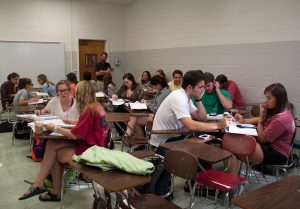by Brendan Ames, Department of Mathematics
 I try to involve my students in my lectures as much as possible. When “discovering” a new formula or method in class, I will usually begin by leading my students in a brief brainstorming session. This is typically in the form of a very informal call and response, where I ask leading questions, such as “What tools do we have to tackle this problem?,” “Why won’t [method we already know] work in this situation?,” or “What should we do next?” I try to avoid writing anything on the board or moving to the next step until one of my students answers.
I try to involve my students in my lectures as much as possible. When “discovering” a new formula or method in class, I will usually begin by leading my students in a brief brainstorming session. This is typically in the form of a very informal call and response, where I ask leading questions, such as “What tools do we have to tackle this problem?,” “Why won’t [method we already know] work in this situation?,” or “What should we do next?” I try to avoid writing anything on the board or moving to the next step until one of my students answers.
On the other hand, if a suggestion is made that will not work, then I will pause and explain why it might not work as an aside. When all is done, we not only have the new formula/algorithm, but we have also seen where it comes from and why it works.
I think this process helps to demystify things quite a bit in the sense that it shows them why a formula works rather than how it works and, just as importantly, shows them how what they already know can be synthesized into new math. This is then reinforced by using the new formula (or whatever we have been deriving) to solve some sort of problem, as well as by more active practice in lab or recitation and via homework assignments.